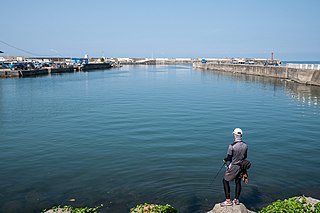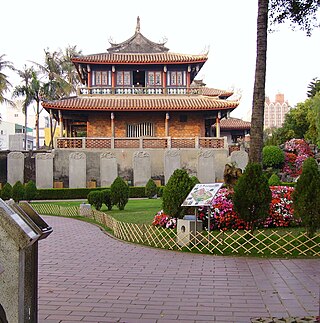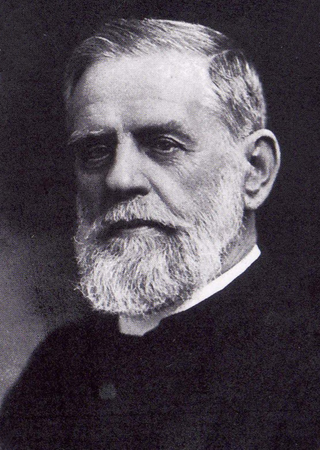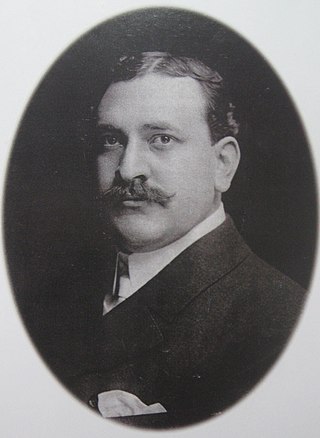
The Republic of Formosa was a short-lived republic that existed on the island of Taiwan in 1895 between the formal cession of Taiwan by the Qing dynasty of China to the Empire of Japan in the Treaty of Shimonoseki and its being taken over by Japanese troops. The Republic lasted 151 days; it was proclaimed on 23 May 1895 and extinguished on 21 October, when the Republican capital Tainan was taken over by the Japanese.

Taiwan Railways Administration (TRA) was a governmental agency in Taiwan which operated Taiwan Railway from 1948 to 2023. It managed, maintained, and operated conventional passenger and freight railway services on 1,097 km (682 mi) of track. Passenger traffic in 2018 was 231,267,955.

Fangliao Township is a rural township in Pingtung County, Taiwan.

Dadaocheng is an area in Datong District, Taipei, Taiwan. It was also known as Twatutia, Daitōtei during Japanese rule, and Tataocheng (Mandarin) during the Kuomintang era.
Taiwan was under Japanese rule after the First Sino-Japanese War, as per the Treaty of Shimonoseki of 1895. There were still several changes until the Japanese political system was adopted in 1920. This system was de facto abolished in 1945 and de jure in 1952.

Cape Santiago is a cape on the easternmost point of the island of Taiwan, located in the Gongliao District, New Taipei City.

Fort Provintia or Providentia, also known as Chihkan Tower, was a Dutch outpost on Formosa at a site now located in West Central District, Tainan, Taiwan. It was built in 1653 during the Dutch colonization of Taiwan. The Dutch, intending to strengthen their standing, sited the fort at Sakam, about 2 miles (3.2 km) due east from modern-day Anping. During the Siege of Fort Zeelandia (1662), the fort was surrendered to Koxinga, but was later destroyed by a rebellion and earthquakes in the 18th century. It was rebuilt afterwards in the 19th century under Qing rule.

Santísima Trinidad was a bay on the northeast coast of Taiwan at Keelung, where in 1626 the Spanish established a settlement and built Fort San Salvador. They occupied the site until 1642 when they were driven out by the Dutch. The Dutch re-shaped the Spanish fort, reduced its size and renamed it Fort Noort-Holland.

The Zengwen River is the fourth longest river in Taiwan after the Zhuoshui River, Gaoping, and Tamsui, with a total length of about 146 km (91 mi). It flows through Tainan and Chiayi County.It is located in the southwestern part of the island.

William Campbell (1841–1921) was a Scottish Presbyterian missionary to Formosa. He wrote extensively on topics related to Taiwan and was also responsible for founding the island's first school for the blind. Interested in the early history of the island, his knowledge of the time was such that he was called "without doubt the greatest authority on this subject living". He was probably the first European to see Sun-Moon Lake, which he named Lake Candidius in honour of the seventeenth century Dutch missionary George Candidius.
The Battle of Chiayi was an important engagement fought during the Japanese invasion of Taiwan in 1895. The battle was a Japanese victory.

James Wheeler Davidson was an American-born Canadian businessman, diplomat, explorer, journalist, and philanthropist. He is remembered for writing The Island of Formosa, Past and Present (1903), a book on the history of Taiwan. He is also noted for greatly aiding the internationalisation of Rotary International.

Zhuluo County was a political division in Taiwan from 1684 to 1787, during Qing Dynasty rule of the island. Initially encompassing the underdeveloped northern two-thirds of Taiwan, the county shrank in size as the population and economy of the northern and central western plains grew and new counties were created out of the developed areas; the Zhuluo county was eventually reduced to an under-developed area in south-western Taiwan. In 1787, the county underwent further restructuring and was renamed Chiayi County.
Zhu Yigui was a Taiwanese military general and rebel. He was the leader of a Taiwanese uprising against Qing dynasty rule in mid-1721.

Taiwan Prefecture or Taiwanfu was a prefecture of Taiwan during the Qing dynasty. The prefecture was established by the Qing government in 1684, after the island came under Qing dynasty rule in 1683 following its conquest of the Kingdom of Tungning. The Taiwan Prefecture Gazetteer documented it as part of Fujian Province. The Gazetteer was completed by Gao Gonggan in 1695, the 34th year of the reign of the Kangxi Emperor. With the development and population growth of Taiwan during the Qing Era, the scope of Taiwan Prefecture was also varied over time. Following the establishment of Fujian-Taiwan Province in 1887, the prefecture correspondingly became a subdivision under the newly founded province.

The Spanish expedition to Formosa was a campaign mounted by the Spanish based in Manila, Philippines in 1626. It was the Spanish response to Dutch settlements being built in Formosa, now known as Taiwan. In cooperation with the Portuguese, this venture was made to attract Chinese traders and curtail the expansion of Dutch power in Asia.
Taipeh Prefecture was a Qing dynasty prefecture created from the northern part of Taiwan Prefecture, Qing-era Taiwan in 1875, while the island was still part of Fujian Province. It consisted of a region surrounding modern-day Taipei, including present-day Hsinchu, Hsinchu County, Taoyuan City, New Taipei City, Taipei, Keelung, and Yilan County. The reorganization started after Imperial Commissioner Shen Baozhen demanded that another prefecture be added in Taiwan to revamp the administrative organization of the northern area of the island. The walls of the prefecture capital were completed in 1884.
Tainan Prefecture was a prefecture of Taiwan under Qing rule. The prefecture was established by the Qing dynasty government in 1887, when Fokien-Taiwan Province was established. The prefecture included the districts/counties of Anping, Kagi, Fengshan, and Hengchun, and the sub-prefecture of Penghu.
Taitung Prefecture was a division of Taiwan Province, which was created after 1887 during Qing rule. The prefecture's seat of government, originally at Tsui-be, was moved to Pi-lam in 1888. Plan to establish the sub-prefectures of Pi-lam (卑南) and Hoe-lian-kang (花蓮港) was aborted.
Events from the year 1874 in China.














